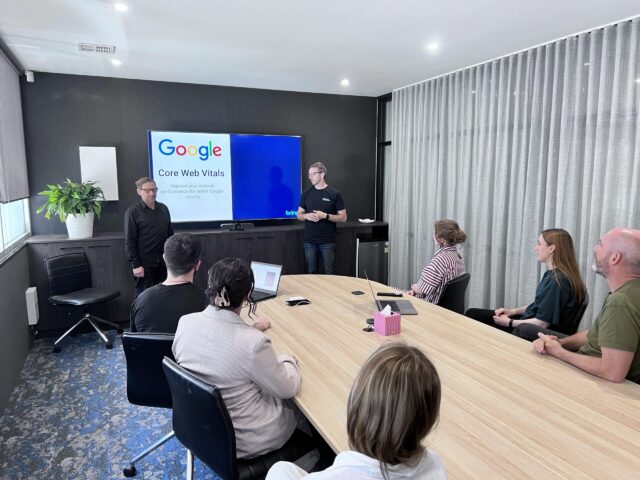In today’s digital landscape, user experience has become a paramount factor in determining a website’s success. Google has recognized this shift and has implemented metrics known as Core Web Vitals to assess the user experience on websites. These metrics focus on three key aspects: loading performance, interactivity, and visual stability. Optimizing your website for these Core Web Vitals is essential for improving user satisfaction and boosting your SEO rankings. In this blog, we’ll explore what Core Web Vitals are and how to optimize your website to meet these standards.

Understanding Core Web Vitals
Core Web Vitals consist of three specific metrics:
- Largest Contentful Paint (LCP): Measures loading performance. It tracks how long it takes for the largest piece of content (like an image or text block) to load and become visible in the viewport. A good LCP score is 2.5 seconds or less.
- First Input Delay (FID): Measures interactivity. It gauges the time from when a user first interacts with a page (such as clicking a link or button) to when the browser responds. A good FID score is 100 milliseconds or less.
- Cumulative Layout Shift (CLS): Measures visual stability. It assesses how much the layout shifts during loading. A good CLS score is 0.1 or less, meaning there should be minimal unexpected layout shifts that could disrupt the user experience.
By optimizing for these metrics, you can improve both user experience and search engine ranking.
1. Improve Largest Contentful Paint (LCP)
Optimize Images and Videos
- Use Next-Gen Formats: Utilize modern image formats such as WebP, which provide better compression without compromising quality.
- Compress Images: Reduce image file sizes using tools like TinyPNG or ImageOptim to enhance loading speed.
- Lazy Loading: Implement lazy loading to defer loading images that are not immediately visible on the screen. This technique loads images as users scroll down the page.
Minimize Render-Blocking Resources
- Reduce JavaScript and CSS Blocking: Minimize and defer loading JavaScript and CSS files that block rendering. Use tools like Google PageSpeed Insights to identify render-blocking resources.
- Inline Critical CSS: Inline essential CSS directly in the HTML to reduce the time it takes for the page to become visually complete.
Utilize a Content Delivery Network (CDN)
A CDN distributes your website’s content across various servers worldwide, allowing users to load the site from a server closer to their location, thereby reducing load times.
2. Enhance First Input Delay (FID)
Optimize JavaScript Execution
- Minimize JavaScript: Remove any unnecessary JavaScript files or code that could delay interaction. This includes eliminating unused code and reducing the size of your JavaScript files.
- Use Web Workers: Web Workers allow you to run JavaScript in the background, freeing up the main thread to handle user interactions without delays.
Implement Efficient Event Handling
- Debounce or Throttle Events: Use debouncing or throttling techniques to limit the number of events triggered during user interactions, ensuring smoother responsiveness.
- Prioritize User Interactions: Make sure that your JavaScript responds quickly to user inputs by prioritizing critical interactions over less important ones.
3. Optimize Cumulative Layout Shift (CLS)
Avoid Layout Shifts
- Specify Size for Images and Videos: Always set dimensions (width and height) for images and video elements. This ensures the browser allocates enough space for them before they load, preventing layout shifts.
- Use CSS for Dynamic Content: If your content changes dynamically (like ads or pop-ups), use CSS to reserve space for these elements to prevent unexpected shifts.
Implement Fonts Properly
- Use Font Display: Use the
font-displayCSS property to control how fonts are rendered. Theswapvalue allows text to be displayed immediately with a fallback font until the custom font loads, preventing shifts.
4. Monitor and Test Your Website
Use Google Search Console
Google Search Console provides insights into your website’s performance, including Core Web Vitals. Regularly check the “Core Web Vitals” report to identify any issues and monitor improvements.
Test with PageSpeed Insights
Utilize Google PageSpeed Insights to analyze your website’s performance. This tool not only provides scores for LCP, FID, and CLS but also offers specific recommendations for optimization.
Conduct User Testing
Gather feedback from real users about their experiences on your website. Use tools like Hotjar or UserTesting to gain insights into user behavior and identify potential areas for improvement.
Conclusion
Optimizing your website for Google’s Core Web Vitals is essential for enhancing user experience and improving your search engine rankings. By focusing on improving loading performance, interactivity, and visual stability, you can create a more engaging and satisfying experience for your users. Implement these strategies and continuously monitor your website’s performance to stay ahead in the competitive digital landscape. Remember, a better user experience translates to higher conversions and long-term success for your business!


No responses yet